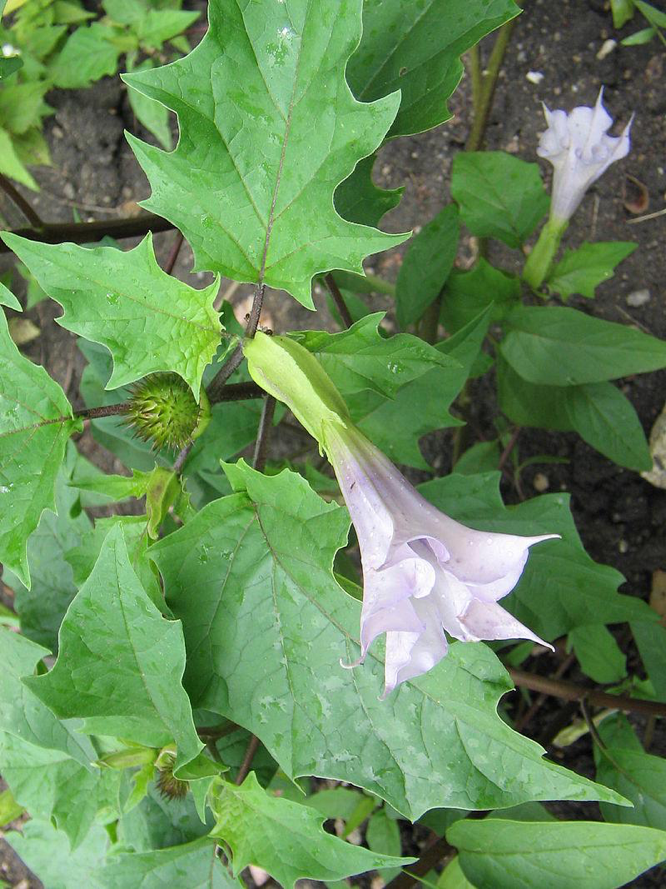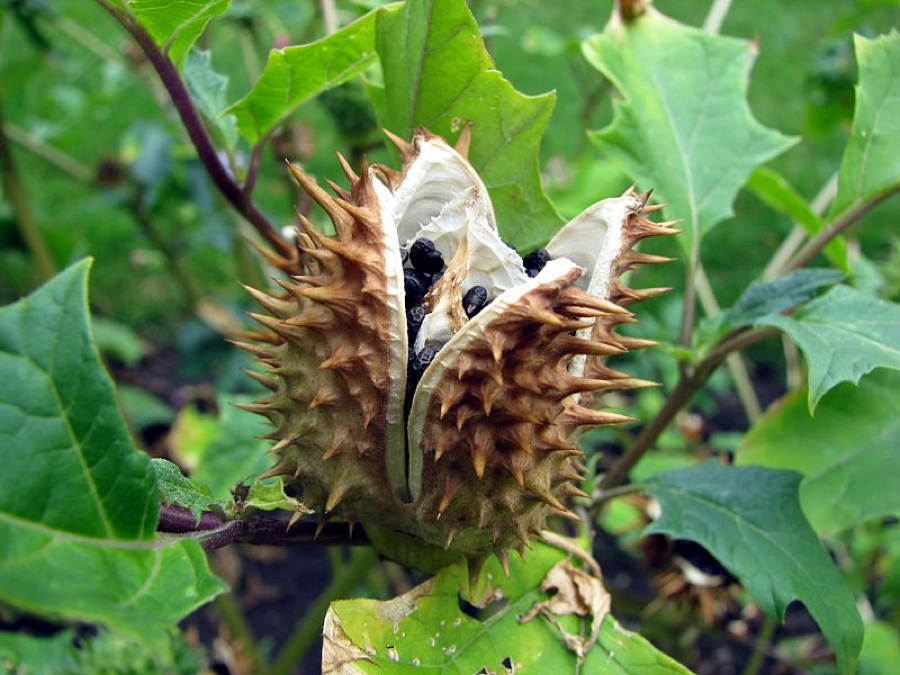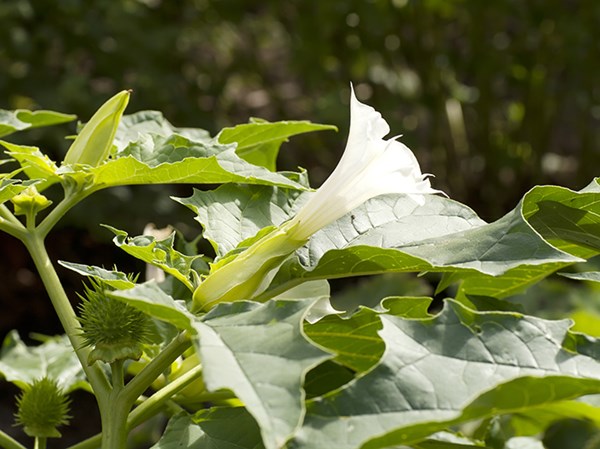A 16-year-old male is brought to the emergency department for confusion and hallucinations for the past hour. Two hours prior to arrival, the patient had reportedly attended a house party where he ingested tea brewed from the seeds of a plant that had "flowers resembling long, white trumpets." The patient has no previous medical history and is not taking any prescription medications. His social history is significant for marijuana and alcohol abuse. He presents with agitation, incoherent speech, visual hallucinations, and seizure-like activity lasting less than one minute. Significant physical examination findings include dilated pupils, flushed skin, pyrexia (38.4 C), tachycardia (125 beats/min), and tachypnea (42 breaths/min).
Introduction
Jimson weed (Datura stramonium), otherwise known as "hell's bells," "devil's trumpet," and "locoweed," is a commonly found weed indigenous to North America.1 The tall shrub can often be seen flowering in warm and moderate regions across the continental United States, growing along roadsides and at dung-rich livestock enclosures.2,3 Plants blossom throughout summer months bearing characteristic white or violet trumpet-shaped flowers (Figure 1). Its thorny and egg-shaped pods contain dozens of small black seeds (Figure 2).4 Belonging to the nightshade family, jimson weed contains alkaloid compounds such as atropine, scopolamine, and hyoscyamine.5 All parts of the plant are potentially poisonous, yet its seeds contain the greatest concentration of atropine (as much as 0.1mg of atropine per seed) and are especially dangerous.6 Chewing, smoking, or brewing the seeds releases the belladonna compounds that provide psychoactive effects sought by many adolescents.7
 This file is licensed under the Creative Commons Attribution-Share Alike 3.0 Unported license.
This file is licensed under the Creative Commons Attribution-Share Alike 3.0 Unported license.
Ingestion of jimson weed can also lead to anticholinergic toxicity.7 Symptoms are dose dependent and may include delirium, hallucinations, agitation, hyperthermia, tachycardia, hypertension, drying of skin and mucous membranes, thirst, nausea, vomiting, skin flushing, mydriasis, blurring of vision, urinary retention, seizures, coma, and in rare cases death.5 Ingestion of doses in excess of 10mg of atropine and 2-4 mg of scopolamine can be fatal.5 Onset of symptoms typically occurs within an hour of ingestion, and clinical resolution, including return of sensorium, can take up to 24-48 hours.7
Diagnosis and Management
The diagnosis of jimson weed toxicity starts with identifying the anticholinergic toxidrome.8 Distinguishing pharmaceutical anticholinergic ingestions from isolated jimson weed abuse is helpful, as ingestions involving diphenhydramine or tricyclic antidepressants, for example, carry the risk of additional toxicity.
As with all cases of poisoning, the acute management of anticholinergic toxicity begins with stabilization of the patient's airway, breathing, and circulation.8,12 Most patients require only supportive and symptomatic treatment. Depending on route of ingestion, gastrointestinal decompression with activated charcoal (1 g/kg; maximum 50 g) in an alert patient may be beneficial.9,12 In patients who exhibit both peripheral as well as central anticholinergic toxicity (eg, delirium and agitation), antidotal therapy with physostigmine (0.5 to 2 mg in adults and 0.02 mg/kg in children; max dose 0.5mg) may rapidly improve symptoms.7,12
Physostigmine treatment may additionally help elucidate the diagnosis in patients with suggestive symptoms but unclear histories.10 Inappropriate use of physostigmine, however, may precipitate cholinergic excess and result in seizures, bradycardia, bronchospasm, vomiting, diarrhea, increased urination and lacrimation, diaphoresis, and miosis.10 In addition, use of physostigmine in patients who have abnormal electrocardiograms because of sodium channel blockade can be fatal. Because the use of physostigmine is not commonplace and may be unfamiliar to many practitioners, consultation with local poison centers and toxicologists is recommended prior to administration.11,12
Disposition
Patients who exhibit minimal signs of anticholinergic toxicity or are otherwise asymptomatic may be discharged after gastrointestinal decompression with activated charcoal and an unremarkable observation period of 6 hours.21
Patients with moderate signs of anticholinergic toxicity with persistent signs of poisoning within the 6-hour observation period may require hospital admission with cardiac and oximetry monitoring until symptom resolution.12
Patients with extensive signs of anticholinergic toxicity requiring physostigmine antidote therapy should be admitted to the hospital until resolution of toxicity.12
Conclusion
In the face of an anticholinergic toxidrome, jimson weed abuse should always be considered among the differential diagnoses - particularly in young partygoers in regions where the plant is endemic. Treatment and disposition ultimately depend on ingested doses of alkaloid compounds atropine, scopolamine, and hyoscyamine, and may require antidote therapy with physostigmine in serious cases.
References
1. Datura stramonium L. United States Department of Agriculture National Recourses Conservation Services website. http://plants.usda.gov/core/profile?symbol=DAST. Updated November 28, 2016. Accessed November December 4, 2016.
2. Montcriol A, Kenane N, Delort G, et al. [Intentional Datura stramonium intoxication: an unknown etiology of mydriasis] Ann Fr Anesth Reanim. 26(9):810-813.
3. Datura spp. (Jimsonweed, Downy Thornapple, Devil's Trumpet, and Angel's Trumpet). Cornell University College of Agriculture and Life Sciences website. http://poisonousplants.ansci.cornell.edu/jimsonweed/jimsonweed.html#jdescrip. Updated September 10, 2015. Accessed November 12, 2016.
4. Jimsonweed Datura stramonium L. United States Department of Agriculture National Forrest Services website. http://na.fs.fed.us/fhp/invasive_plants/weeds/jimsonweed.pdf. Updated November 15, 2016. Accessed on November 12, 2016.
5. Russell J. Jimsonweed poisoning associated with a homemade stew. Centers for Disease Control and Prevention Morbidity and Mortality Weekly Report website. http://www.cdc.gov/mmwr/preview/mmwrhtml/mm5904a3.htm. February 5, 2010. Accessed November 11, 2016.
6. Rosenbaum C, Bird SB. Timing and frequency of physostigmine redosing for antimuscarinic toxicity. J Med Toxicol. 2010;6(4):386-392.
7. Shervette RE, 3rd, Schydlower M, Lampe RM, Fearnow RG. Jimson "loco" weed abuse in adolescents. Pediatrics. 1979;63(4):520-523.
8. Goldfrank LR, Flomenbaum NE, Lewin N. Goldfrank's Toxicologic Emergencies. New York: The McGraw-Hill Companies; 2002.
9. Chyka PA, Seger D, Krenzelok EP, Vale JA. Position paper: Single-dose activated charcoal. Clin Toxicol (Phila). 2005;43(2):61-87.
10. Beaver KM, Gavin TJ. Treatment of acute anticholinergic poisoning with physostigmine. Am J Emerg Med. 1998;16(5):505-507.
11. Burns MJ, Linden CH, Graudins A, Brown RM, Fletcher KE. A comparison of physostigmine and benzodiazepines for the treatment of anticholinergic poisoning. Ann Emerg Med. 2000;35(4):374-381.
12. Su M. Anticholinergic poisoning. In: UpToDate, Post TW (Ed), UpToDate, Walthman, MA. Accessed November 11, 2016.



